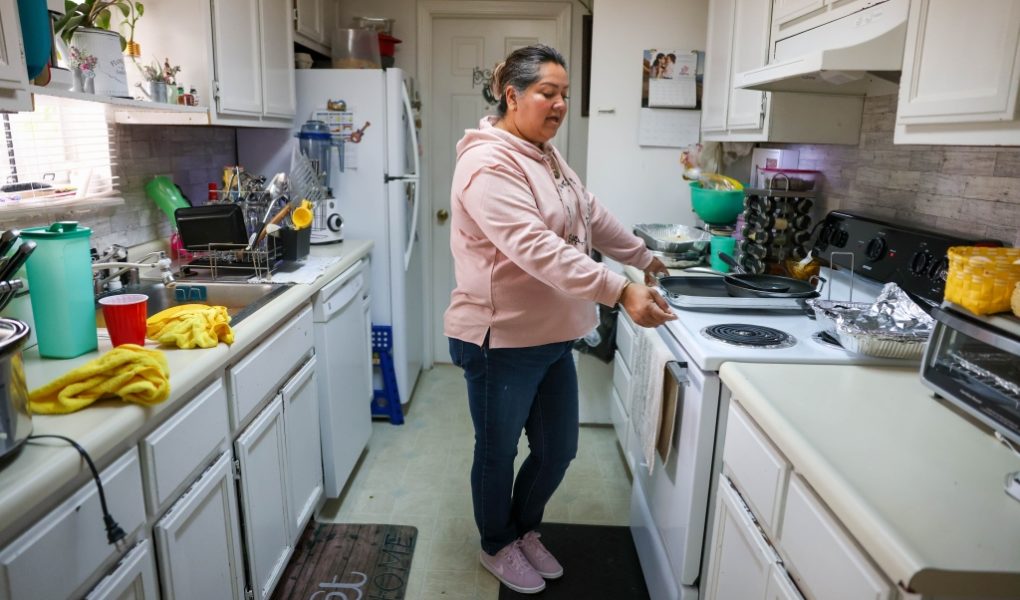Claudia Canchola’s apartment in Cherryland should have been a place of comfort. She envisioned it as a space where she could cook meals for her husband and three young children, spend time together as a family and create a home.
But the shiny promise of Cherryland’s name was lost in the details. This 1.2-square-mile pocket of Alameda County, bordered by three interstates and bisected by a railroad track, has a population of 15,808 and some of the county’s most worrisome health indicators. Asthma rates are high: in the 89th percentile. It’s an area defined in part by its geography, situated amid the toxic emissions from major thoroughfares.
The area also has other challenges: more than 1 in 10 residents live in poverty, 47% have no education beyond high school, and only about a quarter of them live within walking distance of a supermarket.

In the growing statewide conversation about “environmental injustice” — a phenomenon in which poor and marginalized communities face a disproportionate effect of pollution and other unfair aspects of urban planning — Canchola’s experience may not be the first thing that comes to mind.
But Alameda County’s new environmental justice plan, a draft of which is currently open to public comment, could provide help for Canchola and her family.
Their challenges are many. Soon after Canchola moved into the apartment with her husband and three young children, the problems started. They began hearing a loud hum from the pipes in the wall that eventually became so loud her kids could hardly sleep. Water leaked in the upstairs toilet, hot water failed to flow downstairs, a broken stove burner wouldn’t turn off. Fearing a possible fire, she was left monitoring the stove almost constantly.
Her landlord wouldn’t fix them, and eventually, she began to feel there was no way out of her family’s substandard living situation. Two years passed before Canchola finally turned to Alameda County officials for help, but they told her there was nothing they could do. She feared if her landlord found out she called the county, her family would be evicted.
“I was very, very frustrated,” Canchola, who came to California from Mexico, said in an interview. “I felt desperate.”

Alameda’s plan to help families like the Cancholas addresses six pillars of environmental justice including reducing pollution exposure, promoting safe and sanitary homes, and improving food access. It also would establish a centralized office for people in unincorporated areas like Cherryland, where close to 60% of residents are Latino, to make property maintenance requests.
Across the Bay Area, there is a growing recognition that the concept of environmental justice encompasses not only broader systemic issues like pollution but also smaller, more personal ones like these.
“Poor and working-class people of color have the least access to healthy and clean environments,” Ruiz said, an associate professor in the department of Chicano and Chicana studies at Cal State Northridge. “It’s totally about the built environment and the decisions that policymakers have made at the state level, and the local city level, and the legacy of those decisions.”
Although the concept of environmental justice has been around since the 1980s, vulnerable communities have been coping with the environmental burdens of inequitable zoning and related health problems long before the term was created.
In recent years, California has finally made an effort to address these issues. In 2016, Gov. Jerry Brown signed SB1000 into law, which requires jurisdictions to “identify goals and policies to reduce the unique or compounded health risks in disadvantaged communities” as part of their general plans.
Cities and counties are now scrambling to do so, as the state gives indications that it might strengthen enforcement. In 2020, Gov. Gavin Newsom’s Office of Planning and Research released more specific requirements for SB1000. Former state Sen. Connie Leyva, D-Van Nuys, the original author of SB1000, introduced another bill that would expedite the timeline for jurisdictions to adopt an environmental justice plan.
In response, jurisdictions across the Bay Area have begun drafting plans to correct these inequities. Santa Clara County, the city and county of San Francisco, Hayward and San Leandro have all either begun or recently completed some form of environmental justice plans.
Still, as civic leaders across the Bay Area begin to envision a more equitable region, community advocates are skeptical that the same institutions that created this environment are the best suited to fix them.

Leo Esclamado, co-director of organizing and program development for My Eden Voice, a grassroots nonprofit organization advocating for historically disenfranchised communities in Alameda County, said many local residents have said the county’s outreach seemed rushed and inadequate. Just a small portion of concerns expressed by the community ultimately ended up in the action plan drafted by the county, he said.
“We wanted a little more of that action-oriented, naming these issues, and integrating them into specific actions,” said Esclamado, citing lead exposure in houses as one overlooked issue. “These are dire needs. We’re concerned about the way that they are framing some of these actions.”
The 178-page Alameda County draft plan does identify a long list of problems and potential solutions — integrating environmental justice into zoning, investing in the expansion of urban forests and green infrastructure, increasing community engagement in local government, and dozens of other actions.
But the mixed response from community members may be representative of the challenges in creating a document that can cover the breadth of risks poorer communities face as a result of unfair urban planning. Although these plans may help neighborhoods inch toward a healthier future, Alameda County will not be ripping up the freeways running around Cherryland anytime soon.
Among planners, there is also an acknowledgment that draft plans are just one step in a long, winding bureaucratic process. Each plan must still be adopted by the board of supervisors or city council, then passed on to committees, further refined, and voted on again. It’s not clear what actions will be funded, or how long it will take.
“Communities get frustrated, they take their time to participate in community processes, and they’re not seeing the implementation,” said Alison Abbors, a planner with the county’s community development agency planning department. “We tried to build in systems for accountability.”
Canchola and her family, at least, are not optimistic about the county’s environmental justice plan. She continues to live in the same building, facing many of the same problems. If the county refused to help her before, it’s hard for her to believe they will this time.
“I’d certainly like for it to be a transformative moment,” Abbors said. “But of course, it has to go through all the processes of turning into work plans, making it into the budget. That will take time.”

𝗖𝗿𝗲𝗱𝗶𝘁𝘀, 𝗖𝗼𝗽𝘆𝗿𝗶𝗴𝗵𝘁 & 𝗖𝗼𝘂𝗿𝘁𝗲𝘀𝘆: www.mercurynews.com
𝗙𝗼𝗿 𝗮𝗻𝘆 𝗰𝗼𝗺𝗽𝗹𝗮𝗶𝗻𝘁𝘀 𝗿𝗲𝗴𝗮𝗿𝗱𝗶𝗻𝗴 𝗗𝗠𝗖𝗔,
𝗣𝗹𝗲𝗮𝘀𝗲 𝘀𝗲𝗻𝗱 𝘂𝘀 𝗮𝗻 𝗲𝗺𝗮𝗶𝗹 𝗮𝘁 dmca@enspirers.com




